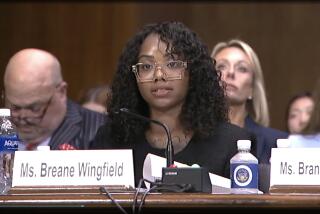Release of Boy Scouts files stirs memories of sexual abuse
Joshua Solomon kept his Boy Scouts uniform in his closet for 30 years, a cotton and nylon reminder of the sexual abuse he said he endured — but never reported — as a 12-year-old in Berkeley’s Troop 22.
“I’ve been refusing to let this piece of history die,” he said.
Last week, he took the uniform out of the closet. His memories of Scouting — and everything the uniform represents — flooded back with the public release of hundreds of previously confidential files on suspected molesters kept by the youth organization.
DATABASE: Track names, locations
The file on his scoutmaster, Steve Kabeary, indicated that eight years after allegedly abusing Solomon he pleaded no contest to molesting four boys. Kabeary was sentenced to eight years in prison.
“I was kind of blown away by it,” Solomon said, describing a mix of regret, anger and relief that welled up while reading the file. “It was validation of what happened to me.”
Solomon was one of about 100,000 people who visited a database of 5,000 files and case summaries posted by The Times on suspected sexual abusers in the Boy Scouts. He and dozens of others contacted the newspaper to describe how events detailed in the documents years ago had shaped their lives.
Used for nearly a century by the Boy Scouts of America to prevent suspected molesters from reentering the organization, the files represent a long-hidden record of alleged abuse affecting thousands of men across the country. The allegations range from rape to fondling to showing pornography to children. Many named in the files were never charged with crimes.
More than 1,200 of the files were released last week by order of the Oregon Supreme Court in response to a petition by various media organizations. The Times obtained additional information for its database, which covers cases opened from 1947 to 2005, from a Seattle attorney who has sued the Scouts on behalf of alleged abuse victims.
Many victims and family members who contacted The Times were hoping for answers to long-standing questions: Were they, or their sons or brothers, alone in being abused? Was the accused ever brought to justice?
“It’s a long, dark chapter in my family’s history that has caused a lot of pain,” wrote the sister of one Scout who alleged abuse. “This will help bring some closure to something we have just been mystified by for so long.”
For others, the files’ release was an opportunity to tell friends and family about a long-buried secret.
“My first reaction was tears,” one man wrote in an email. “Then I realized that I had to say something, as many of my friends and family live in a bubble. They think this kinda stuff doesn’t happen to people that they know. So I popped the bubble.”
On his Facebook page, the man said he was abused by his Florida scoutmaster in the 1980s, writing, “I was one of those boys who didn’t want to say no to anyone, nor did I want to be left out.”
A friend offered immediate support: “I’m pretty proud to know you right about now.”
Several people said they had discovered family members among the alleged perpetrators — sometimes a surprise, but in other cases a sad confirmation of long-standing suspicions.
A 27-year-old Georgia man with an unusual first name called to complain that he was listed in the database erroneously. A quick look at the file revealed that it pertained to a man with the same name who was decades older.
“Oh,” the caller said. “That’s my grandpa, actually…. I’d always kind of heard stories about him.”
Another man named in the files contacted The Times to say he had not molested anyone; at age 22, he said, he’d engaged in a consensual homosexual relationship with a 17-year-old in the troop he led.
Many people expressed disappointment and anger at the Boy Scouts.
“You could see that the Boy Scout council and the church were only concerned about their liability — they could have cared less about us,” said Mike Keller, today a 50-year-old businessman in Mississippi.
Keller always figured that his scoutmaster, Richard C. Hokanson, got off lightly — he was sent to a state hospital for treatment after pleading guilty in 1983 to one of three felony sex abuse charges stemming from his tenure with a Rochester, Minn., troop.
His file referred to allegations involving 16 other boys that were documented by Scouting officials but never prosecuted. Keller said his case was among those not pursued.
“When I finished reading that whole file I ended up taking an hour-and-a-half-long shower. No matter how much I washed, I still felt filthy,” he said. “The last week has been a living hell, reliving everything.”
Hokanson molested him “every Monday night, year in and year out, over six years” ending in 1980, when he made Eagle Scout, Keller said. Hokanson threatened to kill his family if he told anyone about the abuse, which occurred in a storeroom at St. Pius Catholic Church, the troop’s sponsor, he said.
After his hospital commitment in 1983, Minnesota corrections records show, Hokanson was imprisoned for 40 months on a 1994 child sex-abuse conviction. In 2008, he was sent back on a probation violation; he was let out last March on “intensive supervised release,” which includes 24-hour-a-day electronic monitoring.
Contacted by The Times, Hokanson, 77, declined to discuss his file, saying, “My life has straightened around and I’m doing just fine.”
At the very least, Keller said, he’d like “a sincere apology” from the Boy Scouts and an offer to pay for his counseling. He’d also like to see changes in statutes of limitations so he and others abused decades ago might have some legal recourse.
“I haven’t gotten over it, and I never will,” he said.
Deron Smith, a spokesman for the Scouts, said the organization is committed to helping those who were molested — by helping them to find counselors, for instance.
“We have heard from victims of abuse and are doing our very best to respond to each person with our utmost care and sensitivity, offering our support and assistance,” he said.
Smith said abuse victims should contact their local Boy Scout councils or call the national office at (972) 580-2000.
Solomon, the former Scout from Berkeley, said he leaped at the chance to learn more about what the Boy Scouts knew of abuse in his troop in the 1980s.
At the time, Solomon said, he was a smart kid with a bad stutter who was going through a tough time after his parents’ divorce. Kabeary was a charismatic leader in his 30s who claimed to be a Vietnam War hero. All the boys in Troop 22 looked up to him.
One night on a camp-out, Kabeary invited Solomon into his tent and molested him. For months afterward, they’d watch pornography together at Kabeary’s house or go on outings in his Jeep.
Feeling embarrassed and assuming he was Kabeary’s only victim, Solomon didn’t tell anyone for years. Only a decade later did he reveal the abuse, first to a therapist and then to family members.
Then last week he was reading the news online and stumbled across a link to the Times database. Among the 5,000 cases listed were two involving Berkeley’s Troop 22. The dates on both, Solomon noted with alarm, were several years after he had been molested by Kabeary.
Soon after reading Kabeary’s file, Solomon, now 43, went to his bedroom closet and pulled out his old Scouting uniform with Troop 22 emblazoned in white letters on a scarlet background on the sleeve.
“It was a link between me and Steve,” Solomon said. “Something that would show I was a member of this class of kids that was abused by this guy.”
Like others, Solomon is struggling with what to do about this newfound information. He has inquired about filing a lawsuit against the Boy Scouts.
Kabeary died in 2005.
“I’m glad he can’t hurt anyone else,” Solomon said. “But I’m also kind of disappointed that now I can never look him in the eye and tell him that despite everything he did to me, I’m still a strong and loving person.”
DATABASE: Track names, locations
FULL COVERAGE: Inside the ‘perversion files’
Times researcher Maloy Moore contributed to this report.
More to Read
Sign up for Essential California
The most important California stories and recommendations in your inbox every morning.
You may occasionally receive promotional content from the Los Angeles Times.











